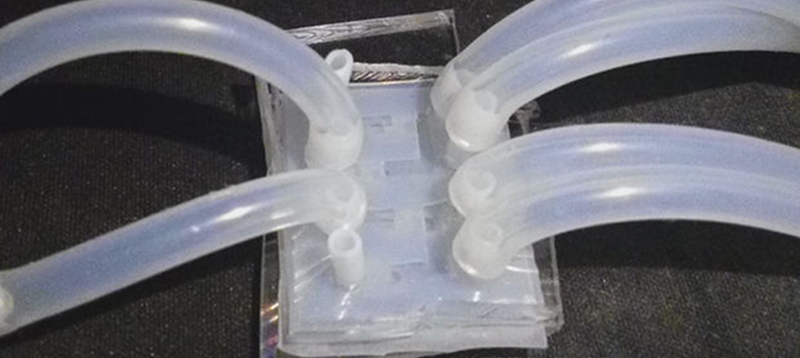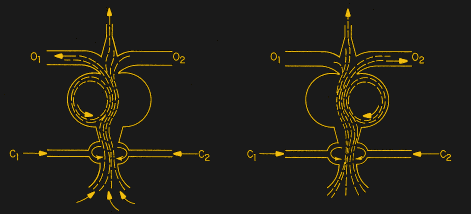We’ve always been fascinated at the number of ways logic gates can spring into being. Sure, we think of logic gates carrying electrons, but there are so many other mechanical means to do the same thing. Another method that sometimes has a practical use is fluidic or pneumatic logic. We guess [dAcid] has a similar interest since he’s written two posts on how to construct the gates. One post covers making them with ordinary tools. The other requires an SLA printer.
According to [dAcid], the design is effectively the same either way, but the SLA printing is more precise. Silicone is an important component, either way. Fluidic logic has applications in some mechanical systems, although digital logic has made it less important than it once was. However, it is very possible that nanotechnology systems will implement logic mechanically, so this is still an interesting technique to understand. You can see videos of how a D latch looks using both methods, below.
The idea is simple. A fluid — keeping in mind that air can be a fluid — is sent into a tube that splits into a “Y” or “T” shape (see figure, below). Small control tubes that are perpendicular to the main flow can force the flow down one leg of the Y or the other. In the case of the figure, O1 and O2 are the branches of the “T” with C1 and C2 allowing control of the direction of flow. There are other variations, including using a vacuum and a pressure on one port to move the main flow and the implementation of basic building blocks.
You might wonder how you can make logic gates out of this until you realize it is nothing more than a demultiplexer. Some FPGAs use multiplexers to implement logic in a regular way, and the idea is the same here. Incidentally, you can view a relay as a mux, as well, and do the same techniques.
In fact, it is surprising just how many ways there are to make logic gates if you try. We are often amused to think that if the Egyptians had used the Nile for pneumatic pressure, they probably had the brick-making technology that the pyramids could have been the first data centers. You can only wonder what they would have computed if they had thought about it.
You can make purely mechanical gates, too. If you have a laser cutter, you are all set.


















Car transmission. Microfluidics are also used in the biological field.
https://www.revolvy.com/topic/Fluidigm&uid=1575
Parker Hannifin has a good intro in the front part of their “Pneumatic Logic & Controls” catalog [PDF]:
https://www.parker.com/literature/Literature%20Files/pneumatic/Literature/Telepneumatic/PCC-4.pdf
interesting.
Unmanned offshore oil/gas rigs => no electricity, inflammable atmosphere.
Fluidic logic controllers look pretty good compared with electronic controllers.
The Tesla valve is a type of fluid diode so it could be possible to fashion a diode array from them to emulate any logical operation via the truth table that it embodies. Add this to the latch method and you have everything you need to assemble a general purpose computer.
Accidental fluidic control in a restroom faucet. https://www.facebook.com/gregg.eshelman/videos/846693265366864/
Think of something like this applied to jet engines where thrust deflection is adjusted by exhaust velocity. Done right it could be used to design a jet that needs thrust angle adapted to different airspeeds. If made so that thrust angles up at lower throttle settings, a quick pull back on the lever would pop the nose up. Taxiing around on the ground would aim the hot exhaust up.
The 1800s are going to be furious that you stole their intellectual property. ;)
That’s Tuttle, not Buttle. Your fluidics need replacement, but you’ll need a 27b/6 first.
Link to a 1967 Popular Science article on making pneumatic logic gates titles “FLUIDICS: How They’ve Taught a Stream of Air to Think”
https://books.google.com/books?id=jSEDAAAAMBAJ&lpg=PA120&ots=Qv5XOnzhg-&dq=fluidic%20listening%20device%20us%20army&pg=PA118#v=onepage&q=fluidic%20listening%20device%20us%20army&f=false
Here’s a 1971 film that has an interesting section on microfluidics: ‘Pioneers for Tomorrow’
https://www.youtube.com/watch?v=cNV-xM1eo7E?t=529